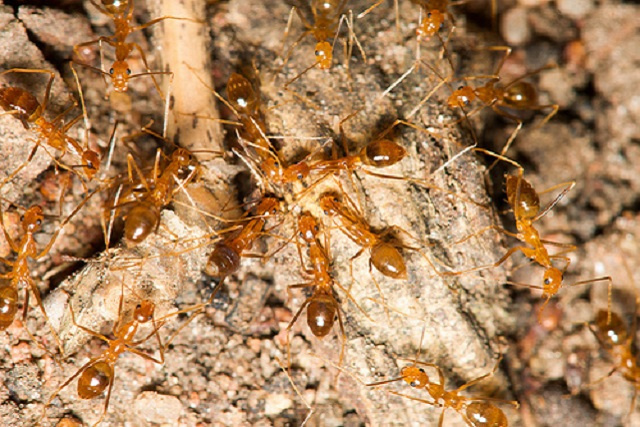Seychelles Islands Foundation changes approach to remove yellow crazy ants on 2 Praslin reserves

SIF started monitoring the yellow crazy ants' population in Vallee de Mai in 2010. (Seychelles Islands Foundation)
(Seychelles News Agency) - A revised protocol has been designed to effectively manage the population of yellow crazy ants in the Vallee de Mai and Fond Peper on Praslin, according to an official of the Seychelles Islands Foundation (SIF).
Jessica Constance, the Vallee de Mai science coordinator, told SNA, "The previous protocol was designed when the yellow crazy ants had up to 100 percent coverage of the Vallee de Mai and stricter measures had to be put in place. Following the successes, a revised protocol has been designed to effectively manage the lower yellow crazy ant abundance in specific areas."
The SIF said in an article in their newsletter that in a recent ant activity survey at five monitoring points, two in the northeastern part of Vallee de Mai and three at Fond Peper, a total of 271 individual invasive ants were counted.
Describing the count as low compared to its distribution before, control measures were put in place. SIF said that this is still a high enough number to cause concern for the endemic species in the palm forest ecosystem.
Constance said, "After four years of broadscale baiting, the new protocol involves minimal and very localised bait deployment to avoid disrupting other species. Instead of site-wide bait dispersal, the bait will now be deployed specifically where the yellow crazy ants occur, a method called spot treatments."
She added that one of the main differences of this new method is that baiting is more targeted and focused on areas with yellow crazy ant presence, now referred to as an extended bait treatment.
"SIF will be observing yellow crazy ants abundance in Vallee de Mai through the ant activity surveys conducted thrice a year. Following the results from this ant activity, only areas that have observed YCA presence will be baited - this will be referred to as spot treatments," said Constance.
Vallee de Mai, a UNESCO World Heritage site, and Fond Peper, are nature reserves managed by the SIF. Both reserves are important for the population of the endemic world's largest nut, the coco de mer, listed as an endangered species by the International Union for Conservation of Nature (IUCN).
 |
| The ants attack wildlife such as skinks and are threats to other species. (Seychelles Islands Foundation) Photo License: CC-BY |
SIF said the yellow crazy ant is an invasive alien species that is known to have destructive effects on ecosystem function, especially in island ecosystems, where it poses a significant threat to native ecosystems. It is listed in the top 10 world's worst invasive species, rapidly spreading in areas as they can nest in almost anything.
The species was first discovered on Mahe, the main island, in 1962, and recorded on Praslin in 1975. It was first recorded in the Vallee de Mai in 2009, and surveys were conducted the same year.
Constance said, "In many places where the yellow crazy ant is invasive, it has had devastating effects on native keystone species, resulting in rapid alteration of ecosystem processes and dramatic negative impacts on endemic species. It can attack prey even larger than themselves like geckos and skinks, with formic acid which may cause blindness, paralysis, or the prey's death. This makes the yellow crazy ant a threat to species and ecosystems much like the Vallee de Mai."
She emphasised the importance of carrying out such exercises especially to protect endemic species and said, "Surveys and studies have shown that the increase in yellow crazy ant abundance in Vallee de Mai resulted in a decreased abundance of native mollusc and gecko species, and a great decline in the endemic white slug species, and palm snail species. A significant decrease in its population coincided with a significant increase in native molluscs, geckos, and the endemic white slug. These species are important contributors to the Vallee de Mai and Fond Peper, proving that the yellow crazy ant baiting is extremely necessary."





